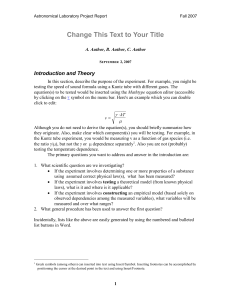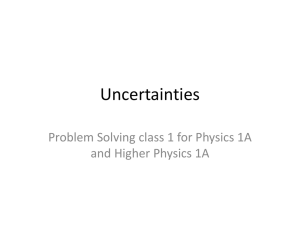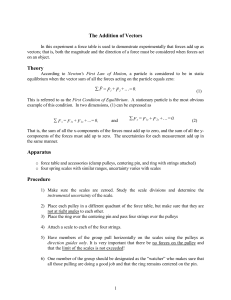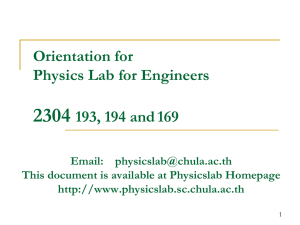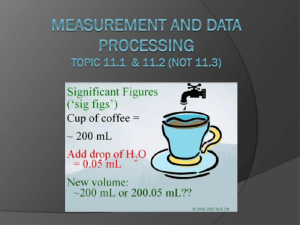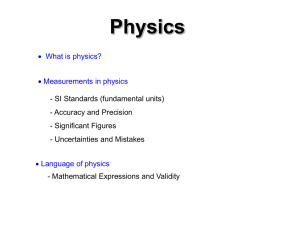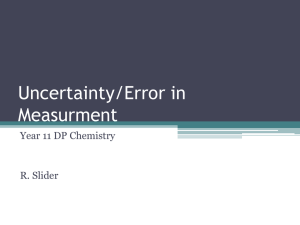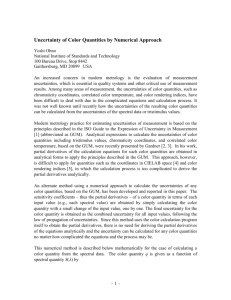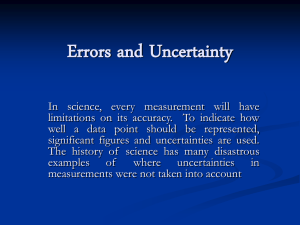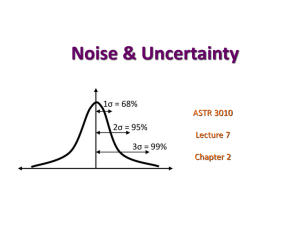Measurement Uncertainties in Excel: A Practical Guide
advertisement
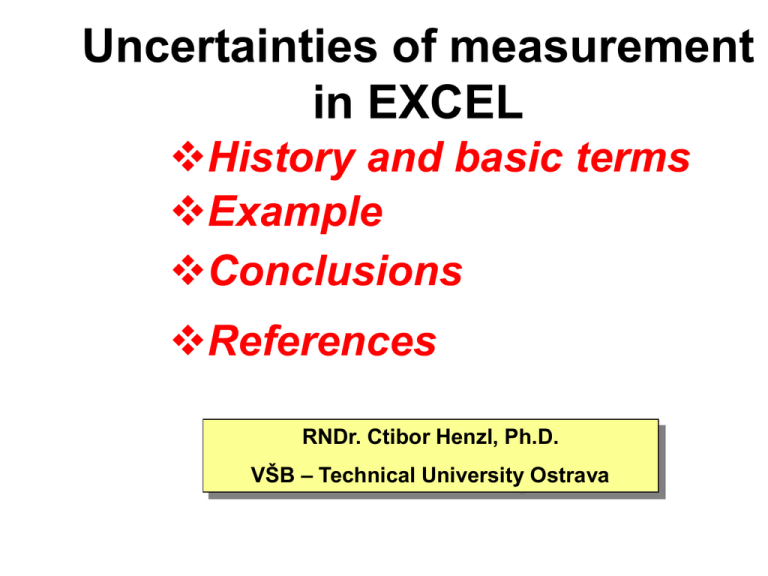
Uncertainties of measurement in EXCEL History and basic terms Example Conclusions References RNDr. Ctibor Henzl, Ph.D. VŠB – Technical University Ostrava Uncertainties of measurement represent a statistical approach to the evaluation of measured data. Alas, approximately since150 years we hear that there are three forms of falsehoods: falsehoods punishable falsehoods statistics This often highly cited proposition about statistics is ascribed on Benjamin Disraeli, other times Lord Palmerston is regarded as the author Benjamin Disraeli(1804-1881) Lord Palmerston(1784-1865) In his beautiful book „Moderní statistika, “Dr. Helmut Swoboda indicates two reasons of this abusive statement: 1.Insufficient knowledge of methods, aims and facilities of the statistics 2.Many people consider statistics as something which is actually pseudostatistics The International Committee for Weights and Measures (CIPM) has committed itself since 70 years of the last century to create an unique methodology for processing and evaluating results of measurement 1977 The International Committee for Weights and Measures (CIPM) asked the International Bureau of Weights and Measures (BIPM) to collaborate with national metrology institutes and elaborate recommendations for the solution of the situation, i.e. recommendation of an uniform approach 1980 recommendation is published as Recommendation INC-1 (1980), see [5]. 1990 West European Calibration Committee issued document WECC Doc. 19-1990 see [6] which is a source for a lot of recommendations and norms, see References. Uncertainties of „A“ type originate from random errors. Their evaluation is based on a statistical analysis of series of observations. Estimation of uncertainties of „A“ type The arithmetic mean (the estimate of the quantity) is calculated n x ji i 1 n xj , j 1,...,m m is number of values, n is number of measurements The sample variance of x j is calculated 2 u Ax j n 1 2 2 x ji x j sx j nn 1 i 1 Experimental standard deviation sx j of the mean is used as a standard uncertainty of „A“ type u Ax j n 1 2 x ji x j sx j nn 1 i 1 Uncertainties of „B“ type originate from systematic errors. The evaluation of this uncertainty can not be based on statistical analysis of series of observations. Relevant information are Experience with relevant materials and instruments Technical documentation Knowledge of previous data etc. Estimation of uncertainties of „B“ type Guess zmax – maximal deviation of value, appropriate to source z and look up relevant probability distribution in the following table Determine uncertainty of „B“ type u 2 Bz z 2 max 2 If deviation cannot be practically exceeded = 3, if deviaton can be exceeded = 2 Gaussian law of propagation of uncertainties Let us assume that y is a function of values x1, x2, … , xm y f ( x1 , x2 ,, xm ) Uncertainty of the every value x1, x2, … ,xm contributes to the resulting uncertainty The mean of y is y f ( x1, x2 ,, xm ) Uncertainty of y , symbolized by uAy is calculated by means of Gaussian law of propagation of uncertainties. The “Matrix form“ of this law is very suitable for computer programming. u 2 Ay f , x1 f , , x2 s x21 f s x2 ,1 xm sx m ,1 s x1, 2 s x22 s xm , 2 f s x1,m x1 s x2 ,m f x2 2 s xm f x m The partial derivatives f /xj (referred to as sensitivity coefficients) are evaluated at X1 x1,, X m xm There are sample variances of mean of values x1,…,xn in the main diagonal of the matrix 2 sx2j u Ax j n 1 2 x ji x j nn 1 i 1 There are sample covariance of means x j , xk in the adjacent diagonal of the matrix sx jk n 1 x ji x j xki xk nn 1 i 1 s x21 s x1, 2 2 s s f f f x2 ,1 x2 2 u Ay , , , xm x1 x2 sx m ,1 s xm , 2 f s x1,m x1 s x2 ,m f x2 2 s xm f x m Off-diagonal elements are zero, if variables x1,…,xn are not correlated. The result is then more f simple u 2 Ay f , x1 f , , x2 u 0 s x22 0 0 x1 0 f x2 2 s xm f x m 2 f sx j X j 1 j X x , X x ,, X x 1 1 2 1 m m m 2 Ay 2 s x21 f 0 xm 0 Gaussian law of propagation of uncertainties must again be applied when calculating uncertainties of type „B“. Combined uncertainty Combined uncertainty uCy includes both types of uncertainties. It is computed as the geometrical mean of uAy and uBy uCy u u 2 Ay 2 By Expanded uncertainty Expanded uncertainty u is the product of the combined uncertainty uCy and the coverage factor k. u k uCy Result The result can be written in the form Y y u If k = 2, estimated values are approximately normally distributed and expanded uncertainty is uCy, then the unknown value of y is believed to lie in the interval defined by u with a level of confidence of approximately 95%. Y y u; y u Example Let us compute the Body mass index (BMI) of a group of students. A group of 15 students 15 years old was chosen among the first year students of the Telecommunication school in Ostrava The personal weighting-machine LUXA and folding rule LOGAREX 38031 were used. Body mass index is defined as the ratio of mass in kg and the square of height in m. m BMI 2 l Mass m and length l are the directly measured values. BMI is calculated for each student. The arithmetic mean, complete with uncertainty of measurement is calculated for the group. BMI and health risk are related (see Table). BMI Status Health risk 18,5 – 24,9 Normal Minimal 25,0 – 29,9 Overweight Increased 30,0 – 34,9 Obesity 1. level Average 35,0 – 39,9 Obesity 2. level High 40,0 and more Obesity 3. level Very High Table of results 2 u Ax j n 1 x ji x j 2 nn 1 i 1 u 2 Bx j 2 zmax 2 Gaussian law Commentaries Uncertainties of „A“ type are computed using formulas u 2 Am n 1 2 2 x x 2 , 12 kg mi m nn 1 i 1 n 1 2 2 2 u Al x x 0 , 0001 m li l n n 1 i 1 The formulas are based on analysis of series of observations statistical Commentaries Uncertainties of „B“ type are computed by 2 z 2 uBx j max 2 zmax is estimated, is determined from distribution of probability, see table Commentaries Estimation of „B“ type uncertainties in our example z max 1 kg, rectangle distributi on u 2 Bm1 2 z max 2 zmax 0,5kg, normaldistribution uBm 2 2 z max 0,005 m, rectangle distributi on u Bl 2 2 zmax 2 2 z max 2 12 3 2 1 0, 3 kg 2 3 0,52 0,027 kg2 9 0,005 2 3 2 8 10 6 m 2 Commentaries The partial derivatives f/xi are calculated from their analytical expression f m 1 1 2 2 0 , 32 m 2 X1 m l m m ,l l l 1,772 2l 2m 2 67,0 f m 3 2 m 4 3 24 , 2 kg m 3 X 2 l l m m ,l l l l 1 , 77 We use the Gaussian law of propagation of uncertainties for calculating uncertainties of „A“ type 2 u 2 Ay 2 f 2 f 2 u Am u Al 0,28kg2 m 4 X 1 X 2 Commentaries The Gaussian law of propagation of uncertainties is used for calculating uncertainties of „B“ type 2 u 2 By 2 f f 2 2 2 u Bm1 u Bm2 u Bl 0,04kg2 m 4 X 1 X 2 The combined uncertainty uc is uc u A2 y u B2y 0,57 kgm2 Commentaries The expanded uncertainty u is u 2 uc 1,1 kgm2 The final result is given by __________ BMI 21,4 1,1 kgm-2 Conclusions Computing of uncertainties of A and B type is described in this paper Computation has been made according to documents WECC doc. 19-1990 and EAL-4/02 A practical-oriented example has been solved Spreadsheet EXCEL has been used for computations References [1] ISO, Guide to Expression of Uncertainty in Measurement (International Organisation for Standardization), Geneva, Switzerland, 1993 [2] NIST Technical Note 1297, Guidelines for Evaluating and Expressing the Uncertainty of NIST Measurement Results, US Government Printing Office, Washington, 1994 [3]Publication Reference EAL-4/02 (European cooperation for Accreditation of Laboratories),1999 [4] WECC Doc. 19-1990 : "Guidelines for Expression of the Uncertainty in Calibrations [5] http://physics.nist.gov/cuu/index.html [6] http://www.european-accreditation.org [7] http://www.bipm.org/CC/documents /JCGM/bibliography_on_uncertainty.html/
